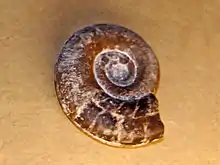Clymenia (ammonite)
Clymenia is a genus in the ammonoid order Clymeniida, restricted to the Upper Devonian, characterized as with all clymeniids by a dorsal siphuncle that runs along the inside of the whorls, unusual for ammonoids.
- For the plant genus Clymenia, see Clymenia (plant)
| Clymenia | |
|---|---|
 | |
| Fossil shell of Clymenia laevigata, on display at Galerie de paléontologie et d'anatomie comparée, Paris | |
| Scientific classification | |
| Kingdom: | Animalia |
| Phylum: | Mollusca |
| Class: | Cephalopoda |
| Subclass: | †Ammonoidea |
| Order: | †Clymeniida |
| Family: | †Clymeniidae |
| Genus: | †Clymenia Swingle, 1939 |
| Species[2] | |
| |
Clymenia has a closely coiled evolute shell that may be faintly ribbed. The dorsum, on the inside of the whorl, is slightly impressed, a result of the outermost whorl slightly enveloping the previous. The venter may be rounded or acute. The suture is simple, with a broad ventral saddle, broad lateral lobe, a dorso-lateral saddle, and a moderately deep hidden dorsal lobe. Septal necks are usually short and do not form a continuous tube. The suture and siphuncle are characteristic of the family.
Clymenia is type genus of the family Clymeniidae. Is fossils have been found in Europe and Western Australia.
References
- Notes
- Sepkoski, Jack (2002). "Sepkoski's Online Genus Database". Retrieved 2014-05-28.
- "Paleobiology Database - Clymenia". Retrieved 2014-05-28.
- Bibliography
- Rocks, Minerals & Fossils of the World by Chris Pellant and Roger Phillips
- Treatise on Invertebrate Paleontology, Part L Ammonoidea; Geological Society of America and Univ of Kansas Press, 1964